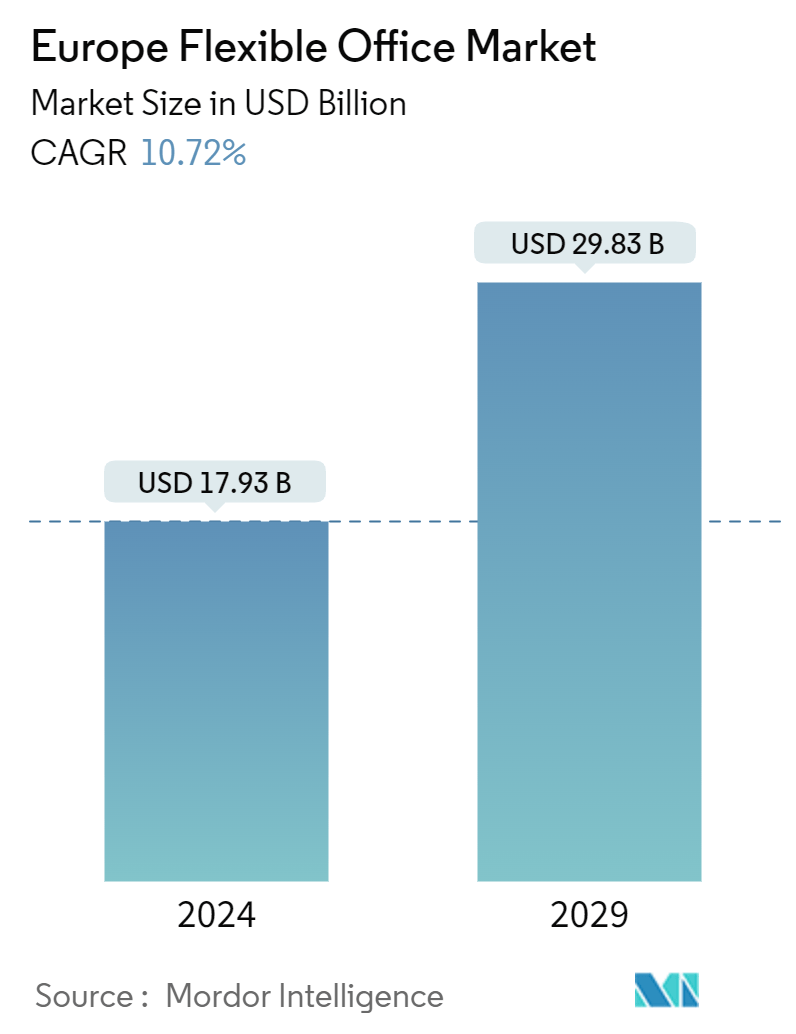Market Size of Europe Flexible Office Industry

| Study Period | 2020 - 2029 |
| Base Year For Estimation | 2023 |
| Market Size (2024) | USD 17.93 Billion |
| Market Size (2029) | USD 29.83 Billion |
| CAGR (2024 - 2029) | 10.72 % |
| Market Concentration | Low |
Major Players
*Disclaimer: Major Players sorted in no particular order |
Europe Flexible Office Market Analysis
The Europe Flexible Office Market size is estimated at USD 17.93 billion in 2024, and is expected to reach USD 29.83 billion by 2029, growing at a CAGR of 10.72% during the forecast period (2024-2029).
- In Q1 2023, flex office take-up in Europe constituted 4% of the total office take-up, marking a decline from its peak of 8% in 2019 and the 7% recorded in Q1 2022. Leading the pack, London City accounted for 13% of the take-up, with Prague at 8% and Amsterdam at 6%. A similar pattern emerged in major US cities, with flex office take-up dwindling from 7% in 2019 to 1.5% in 2023. This trend aligns with a global shift, where smaller operators enter the market and expand their footprint beyond major cities.
- The increase in small and medium-sized businesses is a trend observed across all major cities of Europe, while new working practices are neither location nor sector-specific. These trends have fueled the flexible office market in Europe. The number of startups in the region is expected to boost the market's growth.
- The growing significance of digital systems and the need for completing knowledge-intensive tasks has transformed into a surging desire among employees to work from the office or from any desired location in an independent way.
- This has offered firms in Europe a chance to utilize the office space more proficiently, reduce the traveling hours of employees, and increase employee satisfaction, thereby boosting their work efficiency and productivity. This will help the flexible office market grow during the forecast period.
- Although the demand for flexible office space continues to grow, some obstacles stand in the way of the adoption of this model. Commonly raised concerns include the issues of information security, confidentiality, and privacy in a more open environment. This leads to the companies worrying about the potential impact on their marketing, especially because it could weaken their brands. However, such concerns are outweighed by the risk that companies may need more flexible space in their portfolios. This is due to the developments in the labor market, with many employers worrying about either keeping or attracting the most highly skilled workers.
Europe Flexible Office Industry Segmentation
A flexible office is a workspace that provides employees with various places and ways to work. Unlike traditional offices with fixed and assigned desk positions, workers in a flexible office space can choose the office area that best suits the type of work they need to do.
The European flexible office market is segmented by type (private offices, coworking spaces, and virtual offices), end user (IT and telecommunications, media and entertainment, and retail and consumer goods), and geography (Germany, the United Kingdom, France, and the Rest of Europe). The report offers market size and forecasts in values (USD) for all the above segments.
| By Type | |
| Private Offices | |
| Coworking Spaces | |
| Virtual Offices |
| By End User | |
| IT and Telecommunications | |
| Media and Entertainment | |
| Retail and Consumer Goods |
| By Geography | |
| Germany | |
| United Kingdom | |
| France | |
| Rest of Europe |
Europe Flexible Office Market Size Summary
The European flexible office market is experiencing significant growth, driven by the increasing number of small and medium-sized enterprises and startups across major cities. This trend is further fueled by the evolving work practices that emphasize flexibility and remote work, allowing companies to optimize office space utilization and enhance employee satisfaction and productivity. Despite the challenges posed by the COVID-19 pandemic, which initially led to low occupancy rates due to remote work mandates, the market is rebounding as businesses recognize the importance of flexible office solutions to attract and retain skilled workers. Concerns regarding information security and privacy in open environments remain, but the demand for flexible spaces continues to rise as companies seek to adapt to changing labor market dynamics.
Key cities such as London, Amsterdam, Dublin, Berlin, and Copenhagen have emerged as hubs for the flexible office market, witnessing the highest growth and the introduction of new providers and models. The market is characterized by a fragmented landscape with numerous players, including prominent companies like The Office Group, WeWork, WOJO, Regus Group, and Mindspace, actively pursuing growth strategies to gain a competitive edge. The market's expansion is supported by strategic partnerships and acquisitions, such as Upflex's collaboration with Landmark Space and Industrious's acquisition of Great Room Offices and Welkin & Meraki, which aim to enhance service offerings and increase market share in Europe.
Europe Flexible Office Market Size - Table of Contents
-
1. MARKET INSIGHTS AND DYNAMICS
-
1.1 Current Market Scenario
-
1.2 Technological Trends
-
1.3 Industry Value Chain Analysis
-
1.4 Government Regulations and Initiatives
-
1.5 Insights into Office Rents
-
1.6 Insights into Office Space Planning
-
1.7 Impact of COVID-19 on the Market
-
-
2. MARKET SEGMENTATION
-
2.1 By Type
-
2.1.1 Private Offices
-
2.1.2 Coworking Spaces
-
2.1.3 Virtual Offices
-
-
2.2 By End User
-
2.2.1 IT and Telecommunications
-
2.2.2 Media and Entertainment
-
2.2.3 Retail and Consumer Goods
-
-
2.3 By Geography
-
2.3.1 Germany
-
2.3.2 United Kingdom
-
2.3.3 France
-
2.3.4 Rest of Europe
-
-
Europe Flexible Office Market Size FAQs
How big is the Europe Flexible Office Market?
The Europe Flexible Office Market size is expected to reach USD 17.93 billion in 2024 and grow at a CAGR of 10.72% to reach USD 29.83 billion by 2029.
What is the current Europe Flexible Office Market size?
In 2024, the Europe Flexible Office Market size is expected to reach USD 17.93 billion.

